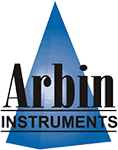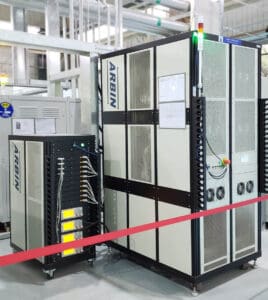A battery intended for a smartwatch should be tested with a slow and steady discharge profile that mimics the watch’s energy use in actuality. Conversely, a battery intended for larger applications such as electric vehicles, should be tested with dynamic test profiles that simulate how a car is used and driven. Battery test equipment should be able to test cells in a way that can accurately examine the cell with regards to its intended application. For instance, Arbin’s Regenerative Battery Testing (RBT) series is designed specifically for high-power batteries used in applications such as electric vehicles, military and stationary grid storage.
All of Arbin’s equipment is designed around the principles of flexibility, safety, and dependability. Learn more about the key features of our RBT series below.
- Made for high-power applications
The RBT series is designed to test large battery packs. Providing wide voltage and current ranges and a high power range of up to 1MW.
The simulation control feature of the RBT allows the system to charge or discharge according to a dynamic test profile. For electric vehicles, this would mean importing a drive profile that mimics how energy and power demand changes during a drive. In an application such as grid storage, the test profile could mimic how the grid would collect and release energy throughout a certain period of time. The ability to conduct tests in this way is important to see how the switching between charging and discharging or the fluctuations in power requirements would affect the battery pack. Making use of true bipolar circuitry, there is no switching time between charging and discharging, meaning that more accurate simulations can be achieved. Each system is also built to run continuously at maximum power so there is no fear of overpowering the system if tests need to be run at high power for long periods of time.
- Easy to program and collect data
Testing systems come with a PC equipped with MITS Pro, Arbin’s software package. The software is completely user-friendly and programming dynamic test profiles is simple. A text profile of time-vs-power or time-vs-current data in .xlsx, .csv, or .txt formats can be directly uploaded to the system. The system can safely handle thousands of data points to run your desired simulation.
Test profiles are completely customizable and easily programmed using dropdown menus. Parameters for different experiment controls such as current, voltage, power, load, and many others can be input directly into the system. All testing channels are completely independent but can also be combined to operate in parallel.
Data can be logged based on changes in Time, Current, or Voltage; data analysis and plotting tools are based in accessible programs such as Data Watcher and Microsoft Excel.
The goal of Arbin’s software is to simplify and streamline the testing process so users can get the most accurate and precise results.
- The system has built-in safety features
Accidents or mishaps in battery testing can be dangerous. Circuit overloads, overheating, overcharging or over-discharging are problems that can occur during testing. MITS Pro also allows users to program safety limits for current, voltage, total power and more. Once a channel reaches the set limit, the system enters a rest state for a period of time, or halts the test altogether.
The system is also equipped with an emergency stop button and multiple levels of fusing to protect it from unintentional misuse. The equipment has onboard microcontrollers that will stop tests if there is a failure that poses a risk. These features are crucial in halting any problems as they arise, ensuring a safe testing environment.
- An economical and efficient solution
One special feature of the RBT system is its use of regenerative circuitry to discharge power back to the grid. The system is able to send power back to the grid with >95% efficiency, making it a more economical solution by decreasing the net energy consumption of the system. This also helps facilitate the overall cooling process by reducing heat dissipation.
The discharge power is also cleaner than before with the total harmonic distortion as low as 3%.
- Customizable to meet your needs
There are multiple auxiliary options that can be added to the RBT system to fit your testing needs. Extra options would allow users to better monitor individual cells within a pack. Temperature measurement channels and temperature chamber interfaces are available, which would give users more flexibility in measuring and controlling temperature during testing. CAN-bus communication is an option to test battery packs with integrated Battery Management Systems, which can help communicate valuable messages to the MITS Pro software. Digital or analog input/output modules can further help control testing procedures.
A comprehensive system that provides easy to use features greatly facilitates the testing process. High-power dynamic applications especially require strong and power-efficient equipment to conduct meticulous and rigorous testing and ensure safe procedures.



